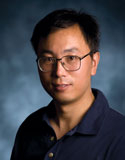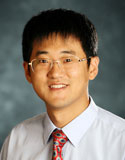Study could expand device capabilities
On a bright day, every 10 square feet of the earth’s surface is exposed to near 1,000 watts of energy from the sun. That translates to about 1 kilowatt an hour—easily enough to power our modern lives for free.
There is just one problem. The solar cells responsible for turning this bounty of sunbeams into energy are only capable of capturing certain rays from the sun.
But Jiming Bao and Qingkai Yu think they have a solution.
Bao and Yu, both researchers in the University of Houston Cullen College of Engineering, believe restructuring silicon—key in producing the electrical current solar cells generate when struck by sunlight—may allow them to catch more of the energy-rich rays present silicon-equipped solar cells cannot.
“This is a new type of silicon; it has a different electronic structure,” said Bao, assistant professor of electrical and computer engineering and lead investigator on the project. “This type of silicon will have a lower band gap, and be able to convert infrared light into electricity where right now you can only convert visible light. It should make the solar cell more efficient.”
Earlier this month, Bao and Yu, research assistant professor of electrical and computer engineering, were awarded a $348,645 grant from the National Science Foundation to support their efforts.
During the next three years, the two will work at the nanoscale to create silicon with a new, hexagonal structure. Already widely used in electronics and solar cells, present silicon uses a diamond or cubic structure.
Through the use of a method called chemical vapor deposition, Yu will grow silicon nanowires. The technique will heat silicon compounds, breaking down their molecular structure and depositing silicon on the surface of a metal catalyst in nanometer size. This, in turn, will promote the growth of the new silicon nanowires— just a few millionths of a centimeter thick.
“We will need to figure out our own recipe for this,” Bao said of the first phase of the research. “Really what catalyst and gases to use to make this happen.”
Once successful, Bao will work to refine the material’s hexagonal structure, later testing its effectiveness by creating a device using these nanowires.
“Silicon is already an important material for our electronic devices, solar cells and for everyday life,” said Yu. “A new type of silicon could expand a lot of applications of silicon. If this project goes smoothly, we will have an impact on this industry.”

